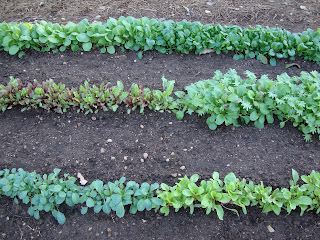When I made a small garden in the corner of the backyard, I told myself that it was experimental. I didn't know if that space would receive enough light to support plants. At the time, several weeks before I began the process of digging up and terracing part of the front yard to make a garden there, that backyard corner was the best potential garden spot that I had, and I was itching to use a pile of mulch that I had to build a garden. So rather quickly, over just two humid summer mornings, the backyard garden was created. And just as quickly, my expectations shifted from This is experimental to This is going to work.
Overall, it hasn't yet not worked. The transplanted broccoli, cabbage, cauliflower, and collard plants established quickly and grew new sets of thick, dark-colored leaves. The seeds that I planted germinated into dense rows of seedlings, the thinnings of which made delicious salads. Soon I had neat rows of seedlings and a patchwork of established cabbage-family plants, each preparing to make a head of flowers, or leaves, or florets. In the last few weeks, leaves from the cedar elm above have begun falling onto the garden below. As the yellow and brown leaves accumulate, I can see the quiet, private backyard garden that I imagined coming into focus.
But, of the rows of seeds that I planted, only some of the seedlings made the transition from seedling to baby plant. The baby chard plants happily grew ruffly fourth and fifth sets of leaves and the beet plants, though still small, responded to the low-light conditions by producing new leaves with deep-red undersides, which reflect light back into the leaf for photosynthesis. The lettuces grew as well, quickly taking on the look of small, loose-leaf lettuce heads. The cabbage-family seedlings, in contrast, stalled out at the seedling stage. The arugula and bok choy rows shrank as the seedlings receiving the least light faded into the soil. The Chinese kale seedlings simply stopped growing, standing tall with just two or three sets of leaves, waiting.
I might have been patient with the slow progress, writing it off as slow growth due to the lower temperatures or shorter days, except that the greens in the front yard, planted a few weeks later, make it very clear that lack of light is the culprit. The front-yard greens, long grown past the need-thinning stage, are putting out new sets of leaves by the day.
Then came the bugs. I'm not sure if they were caterpillars, or beetles, or some yet-unidentified creature from the compost, but something made a meal of those poor, struggling baby plants. Last week, I noticed that, not only were the bok choy, arugula, and Chinese kale seedlings still frozen in time, not growing much, but they were also being devoured. I decided that it was time to admit that part of my experiment didn't work. I pulled the remaining bok choy, arugula, and Chinese kale seedlings and set aside the leaves that hadn't already been eaten by bugs for salad.
The bright side of one failed experiment is that I get to start another, which in the garden means planting more seeds. I planted butterhead lettuce, my favorite type of lettuce, next to the established lettuces. I also planted spinach, a monster variety, and mache, both of which are cold-loving greens that are known to germinate in cold temperatures. I have never planted this late in the year before so, given how early we are having freeze warnings this year, I have begun yet another experiment.
Soon the rest of the leaves will fall from the trees that shade the backyard, allowing more light to reach the garden. While I now know that the light will be strong enough to slowly grow greens - chard, beets, and lettuces - I still wonder if the broccoli, cauliflower, and cabbage plants will receive enough light to make their heads. Which means that my backyard garden, like all gardens, will continue to be an experiment.






No comments:
Post a Comment